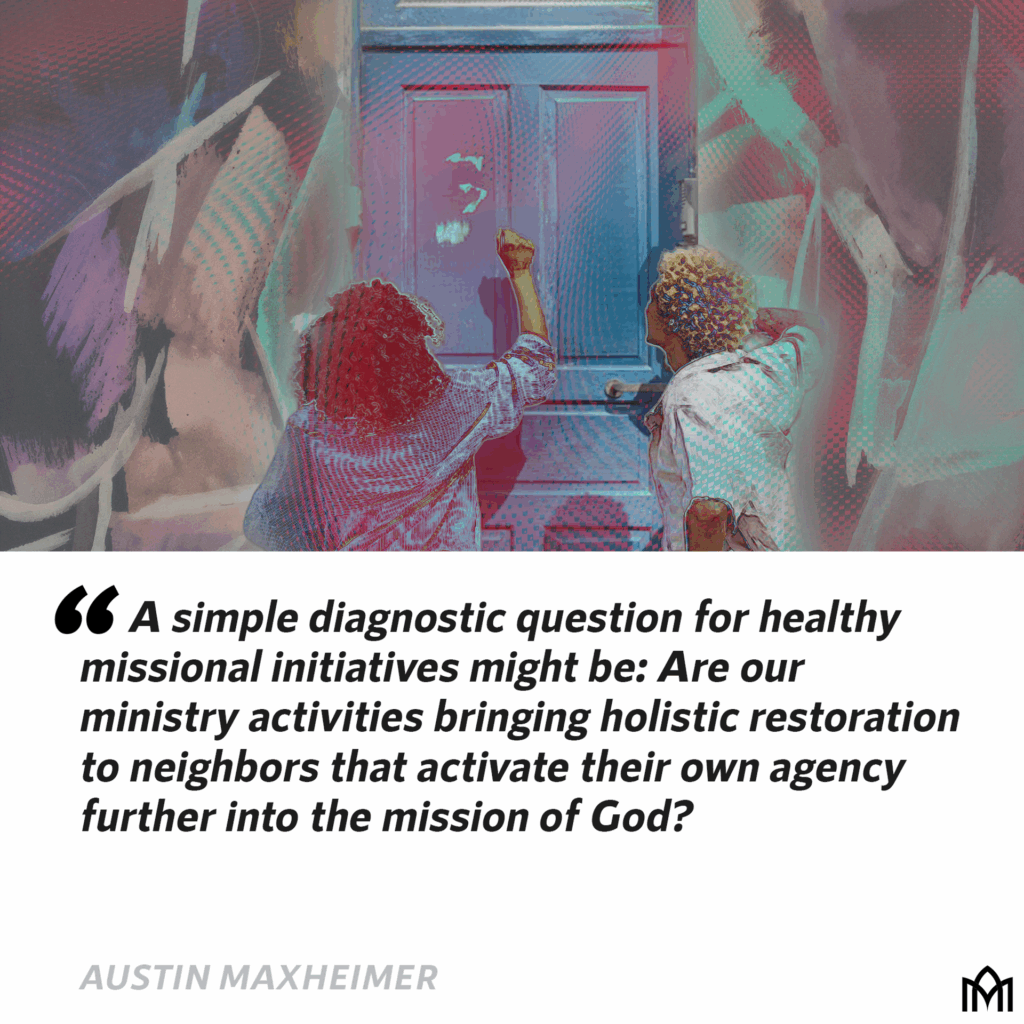Love Your Neighborhood
*Editorial Note: Austin’s first article in this series is entitled “Who Are Our Marginalized Neighbors Today?” and can be read here. ~CK
In my city 80% of our neighbors experiencing poverty live in just thirteen urban core neighborhoods.1See “The State of E Report” for Evansville, Indiana, accessed May 4, 2025 at https://www.forevansville.org/stateofe. Evansville also has over 250 churches call our city home, not to mention many more Christian non-profits and parachurch ministries. What I see when I look out at this landscape is the opportunity for us to bring Jesus’ words in the Sermon on the Mount to life: “You are the salt of the earth…you are the light of the world, let your light shine before others, so that they may see your good works and give glory to your Heavenly Father” (Matthew 5:13-16). We have an opportunity to fill the vacuum in our culture that has failed to bring hope and tangible transformation, as a testimony and witness to the Good News of Jesus Christ.
In order to do that, we need to shift our philosophy of ministry to holistic restoration of neighbors and neighborhoods. Here are five proven methods in which following Jesus’s incarnational mission can shape us into more effective Kingdom ministers.
- Rediscover the Importance of Place
Have you ever reflected on the fact that Jesus spent the first thirty years of his missional life largely rooted in his small hometown of Nazareth, which boasted an estimated population that many scholars thought was much less than 1,000 people? Two-thirds of his public ministry was in the wider region of Galilee, a relative backwater province in Israel. This area formed Jesus, and we must conclude that place is important. For thousands of years a persons’ entire life was lived in one place, and the local church cared for the place in which it was planted. This is a critical observation to remember in our global, modern day as we rediscover the inordinate influence place has on the relative flourishing of a neighbor’s life. For example, most church outreach programs would not think about how repairing sidewalks in a neighborhood promote mobility, positively effecting physical health, increase social interactions helping emotional health, and generate safety aiding in mental health.2Jeff Speck, Walkable City: How Downtown Can Save America One Step at a Time (New York, NY: North Point Press, 2012), 17-34. Or the damage that a dilapidated house or business does to the perceptions of economic vitality of its neighbors. I could go on.
Churches have largely vacated responsibility for transforming the infrastructure of neighborhoods to government and other civic agencies. I like to imagine what cities would look like if every church adopted five blocks around their building. How powerful that witness would be!
- By Taking an Asset-Based vs. Deficit-Based Approach
How you “take care” of those five blocks matters though. Early thought leaders like Robert Lupton (author of Toxic Charity) and Steve Corbett and Brian Fikkert (co-authors of When Helping Hurts) have shed a light on the reality that many church outreach activities actually contribute to cycles of dependency, hurting the very people God calls us to help. This stems in part from seeing our neighbors from a position of lacking. I vividly remember the first time I went door-knocking to listen to neighbors in my neighborhood from the perspective-shift of “My neighbors are not people of need, but potential Kingdom builders! My neighbors are created in the Image of God and therefore have inherent dignity and infinite worth.” This experience began a journey for me to see all neighbors as our Father sees them: a beloved family capable of changing the world.
I began to see how Jesus activated people into Kingdom work all throughout the gospels. I found myself wondering, Why is the leprous man not the temple preacher? The woman at the well not the Samaritan evangelist? Zacchaeus the wee little man instead of a deeply generous economist? The adulterous woman not a future missionary? I do not want to minimize the very real need people feel, but only focusing on their deficit has not worked. Let’s try a more dignified approach.
Churches have largely vacated responsibility for transforming the infrastructure of neighborhoods. I like to imagine what cities would look like if every church adopted five blocks around their building. How powerful a witness! Share on X
- While Being Present on the Missional Frontier
Jesus had interactions with marginalized neighbors because he lingered in the margins. Our communities are designed to isolate disinvested neighborhoods. Proximity is half the battle. For example, my neighborhood is cut off by a highway, with little to no entertainment, restaurant or stores present. There is no reason for anyone in our city to come here unless they live here. When our church kicked off our first neighborhood initiative, a friend of mine used to go multiple times a week to drive around and pray. This is not exactly how I would equip people to engage now, but I share it as an example that anyone can draw near to neighbors. Of course, Jesus left the heavens to draw near to us and be present, so if we are following him, we ought to seek real presence with our neighbors as well. This pattern of embodied, missional presence is why Jesus went to the lonely places where the lepers lived, asked for a drink at the well at Sychar at noon, and sought to have dinner with Zaccheus as he sat in the sycamore tree in Jericho.
- Using the Process of Listen-Align-Act
Consistently, Jesus’ approach is this: He initiates a conversation with people, asking thoughtful questions, listening to their responses. Slowly, he aligns their needs with the expansive Kingdom of God, delivering restoration and healing as people are sent out into missional activity. This process is opposed to the typical way we try to help neighbors in outreach ministries, which often looks something like this: We know what is wrong with you. We have what will fix you, so please come to us. Only then will we give you what you need. Rosabeth Moss Kanter says, “When change is done to you, it is experienced as violence. When you are the agent of change it is experienced as liberation.”3Quoted by Cormac Russell in his presentation at the TEDxExeter Conference, “Cormac Russell on Sustainable Community Development: From What’s Wrong to What’s Strong at TEDxExeter,” February 2, 2017. When we do for neighbors, we steal their agency, and when to do that, we mirror the bondage of the world, not the freedom of the Gospel. And yet, we live in systems that have stolen agency and created injustice for generations. As outsiders to marginalized neighborhoods, we have chronically overpromised and underdelivered. Actions must be taken to show that things are different, and that transformation can only be affected by real relationships and abiding trust. Taking action should not be accomplished as a stranger, and you can remedy that by listening first.
Jesus had interactions with marginalized neighbors because he lingered in the margins. Our communities are designed to isolate disinvested neighborhoods. Proximity is half the battle. Share on X
- Through Practicing Embodied Values
What does God instruct Israel to actually do in their relationship with orphans, widows, and strangers (OWS)? How should they act? God gives many imperatives as a way of life for His people that I like to think of as ‘practices of embodied values.’ I can only give one example in this space: gleaning. Gleaning was the practice of leaving some produce in the field, which then their OWS-neighbors could come and harvest for themselves. This was clearly a sacrifice by the landowner against their crop’s potential total yield, but it was also a practice of generosity and inclusion that allowed marginalized neighbors onto your land in the first place. Welcomed into a place, marginalized neighbors could harvest gleanings in dignity while having their physical needs met.
The important takeaway from the practice of gleaning is that a community of faith must be commissioned to adopt practices as a collective that embodies the values God wants for all of creation. The application to neighborhood revitalization as an engagement vehicle for the Church today is applies this same commissioning. A simple diagnostic question for healthy missional initiatives might be: Are our ministry activities bringing holistic restoration to neighbors that activate their own agency further into the mission of God? Or at very least contributing to that reality? If not, then you may want to incorporate some practices that intentionally embody the values of our faith.
In summary, neighborhood revitalization can be defined in the following manner:
To transform mission to marginalized neighbors, we must rediscover the importance of place, by taking an assets-based approach, while being present on the missional frontier, using the process of listening-aligning-acting, practicing the embodied values of Jesus Christ.
All of these concepts, in one form or another, reflect an aspect of ministry that is rooted in a deep incarnation of place. At my workplace we call these ‘the 4 P’s of Jesus’ ministry: Presence, Proximity, Place and Posture.’ I love this framing in our neighborhood work, because it reflects the ultimate goal of why we engage missional work in the first place, which is so that we can all be formed more into the likeness of Christ. This framing beautifully blurs the lines of service and formation. Perhaps it is not so much that the neighborhood needs you, but that you need the neighborhood as well, as we all are changed.
///
A simple diagnostic question for healthy missional initiatives might be: Are our ministry activities bringing holistic restoration to neighbors that activate their own agency further into the mission of God? Share on X




